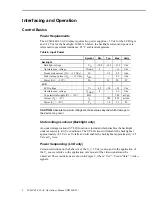
LC640.480.33-AC Operations Manual (OM600-01)
5
Vent Clearance
The LC640.480.33-AC display is a wide temperature display utilizing convection
cooling. It is imperative to allow ambient air unrestricted access to the cooling vents in
order to reliably operate the display at high temperatures
The vents for the lamp cavity are along the top and bottom edges of the display with the
openings facing the rear. The vents for the inverter cavity are along the top and bottom
faces of the display: four along the top surface and four along the bottom surface. Refer
to the mechanical outline drawing in Figure 15 for vent locations.
Isolation/Air Gap
The display generates high voltage AC to drive the CCFL tubes. High voltage is present
at numerous points on the backlight/inverter ECA which forms the rear surface of the
display, so your application should not place metal too near the ECA. In the interests of
both high voltage isolation and airflow for cooling, it is recommended that an air gap of
.197" (5 mm) or greater be maintained behind the display.
Ambient Light Sensor Clearance
Two backlight dimming modes utilize automatic brightness control (ABC). If the display
is to be operated in either of these modes, the ambient light sensor located on the front
bezel must be unobstructed. If the sensor is placed behind the same protective window as
the display active (viewing) area, the sensor operation may be affected due to light
scattering and reflections from display-generated light coupling to the sensor via the
window.
Cable Length
Due to the high frequencies present on the video interface, unterminated video cable
lengths of more than two feet (600 mm) are discouraged.
Cleaning
Care should be taken to minimize scratching. Clean the display front with a dry, soft
cloth such as a professional photographic lens cleaner. Disposable cleaning cloths are
recommended to minimize the risk of inadvertently scratching the display with particles
embedded in a re-used cloth. Particular care should be taken when cleaning displays with
polarizers or anti-glare and anti-reflective films. These films may delaminate if exposed
to certain chemicals.
Avoiding Image Retention
Image retention may occur when a fixed pattern is displayed for a long time. Use a
screen saver or image inversion to avoid image retention on the display.








































